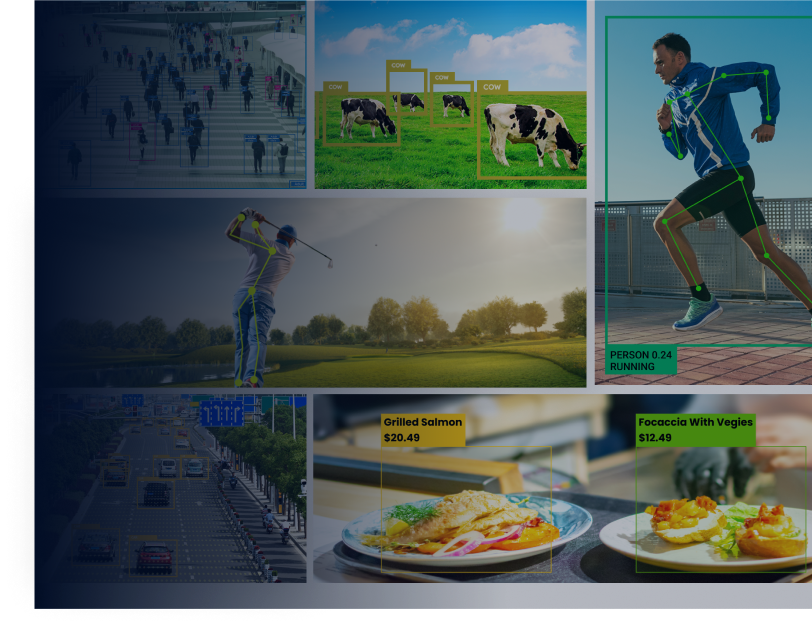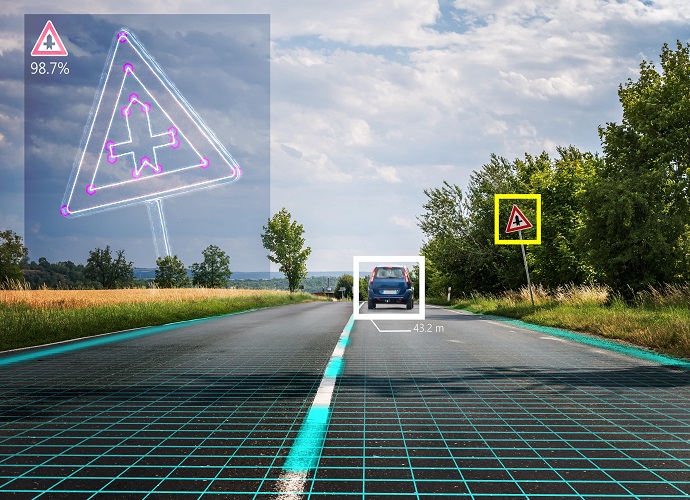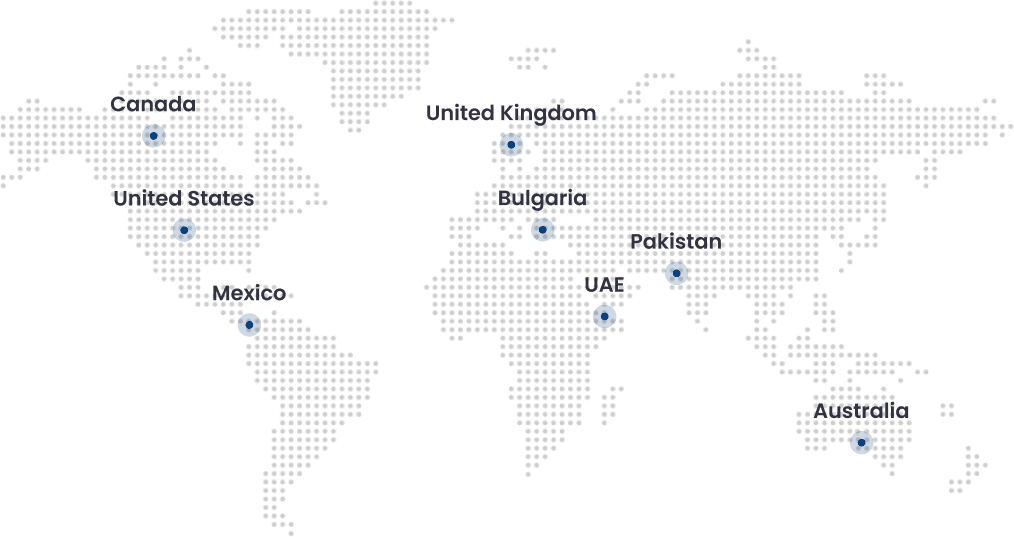Now, we have a world where machines not only see but can interpret the visual world around them. This is the power of computer vision technology. But what is computer vision? It is a branch of artificial intelligence that helps computers comprehend pictures and videos. Through the use of machine learning and neural networks, it can identify problems, recognize things, and make judgments faster and more accurately than humans.
The industries that used computer vision applications generated revenue of $20.31 billion in 2023 and grew fast. They are expected to reach $175.72 billion by 2032, showing how quickly this technology is being adopted (Source).
This blog will explain in detail this technology, computer vision applications, and how it differs from image processing.
What Is Computer Vision?
Computer vision is a branch of artificial intelligence (AI) that employs machine learning and neural networks to assist computers in understanding information from digital photos, videos, and other visual inputs. Based on the visual data it processes, the technology can identify errors or problems and recommend solutions.
It works like human vision but in a different way. Humans use their lifetime experiences to recognize objects, judge distances, detect movement, and spot issues in images.
On the other hand, computer vision uses cameras, data, and algorithms to do similar tasks much faster. With these tools, a system trained for visual inspection can check thousands of products or processes per minute, finding small defects or issues that humans might miss, thus outperforming human capabilities.
How Does Computer Vision Work?
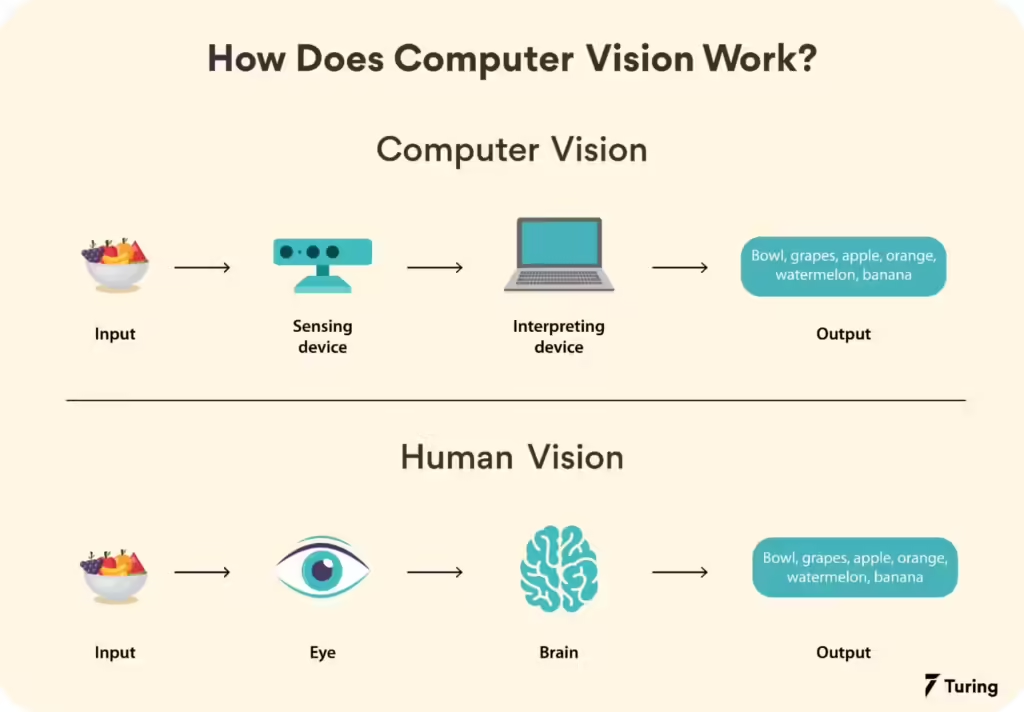
When discussing this technology’s workings, one word perfectly sums it up: “data.” Computer vision demands an abundance of it to perform optimally. It constantly reviews this data to find patterns and differences, helping it recognize images.
For example, to teach a computer to identify car tires, it needs many images of tires and related objects to learn the differences and correctly spot a defect-free tire.
To understand the workings of computer vision technology, we need to focus on two important factors:
-
- Deep learning, a part of machine learning,
-
- Convolutional neural networks (CNNs).
Machine learning uses algorithms to help computers understand visual data on their own. With enough input data, the computer learns to tell different images apart without needing specific programming for each one.
On the other hand, A CNN helps by breaking down images into pixels, which are labeled. These labels allow the Convolutional neural networks (CNN) to perform convolutions—math operations that combine two functions to produce a third. It helps CNN predict what the images show.
The neural network runs these convolutions repeatedly, improving its predictions each time. The whole process allows the computer to recognize or “see” images in a way similar to humans.
Similar to how a person spots a distant object, a CNN begins by recognizing simple shapes and edges and then adds more details through several prediction steps. While CNNs analyze individual images, recurrent neural networks (RNNs) are used for videos, helping computers understand the connections between frames in a sequence.
For example, in a quality control setting at a manufacturing plant, a computer vision system can be trained to check products on a conveyor belt. By showing the system thousands of pictures of perfect and flawed products, CNN can learn to spot small defects.
Over time, it becomes skilled at finding defects faster and more accurately than human inspectors, boosting the overall efficiency and dependability of the production process.
Bonus Read: Best CNN Architecture For Image Processing
Why Is Computer Vision Important?
Computer vision technology empowers humans to get insights and comprehend the massive amounts of visual data surrounding us. Whether it’s social media posts or surveillance footage, this data contains useful insights that are practically impossible to extract manually.
Human intervention is still necessary to interpret data and make decisions. However, only computer vision algorithms can efficiently analyze any visual data. The processed data is then available to help make decisions, spot patterns and trends, automate operations, and much more. It has many benefits other than image analysis.
Bonus Read: What is Zero-Shot Learning in Computer Vision?
8 Common Computer Vision Use Cases
Computer vision is a quickly growing field with numerous applications. It has become an essential aspect of many industries, including healthcare, retail, manufacturing, automotive, agricultural, security, and surveillance. Here are some common uses of computer vision:
-
-
Healthcare
-
Healthcare technology is making big improvements in patient care. For example, Medical Image Analysis uses smart software to help doctors read medical images better and faster, leading to better diagnoses. Another cool area is Surgical Assistance, where high-tech tools and robots help surgeons do complex operations more accurately.
Bonus Read: Computer Vision for Medical and Healthcare Imaging Solutions
-
-
Automotive and Transportation
-
The automotive and transportation industry is rapidly changing. A major advancement is self-driving cars, which use advanced technology to operate without human drivers and could make roads safer by reducing accidents.
Another key development is in traffic management, where technology is used to monitor and control traffic flow, cutting down on congestion and improving travel times. Both of these innovations are making transportation more efficient and convenient for everyone.
Bonus Read: Benefits of Computer Vision for Defect Detection and Scaling in Automotive
-
-
Retail
-
Technology has changed shopping a lot. Now, with automated checkout systems, customers can scan and pay for items without needing a cashier, making shopping faster and more fun.
Also, inventory management is better now. Modern systems help stores keep track of stock levels accurately, so products are available when customers want them.
-
-
Manufacturing and Industrial Automation
-
In manufacturing, quality checks and robots are changing things a lot. Quality checks make sure products are good, keeping customers happy and protecting the brand. They find problems early, so products stay reliable and consistent.
Robots do repetitive and precise tasks very accurately, which boosts productivity and reduces mistakes. They also do dangerous jobs, making the workplace safer for people.
-
-
Security and Surveillance
-
Today, security and keeping an eye on things are very important. Facial recognition helps people recognize others by looking at their faces. It’s used for unlocking phones and keeping public events safe.
Anomaly detection looks for unusual things that might be a danger. These technologies make security better, stop unauthorized access, and keep people safe. They are important for protecting everyone.
-
-
Agriculture
-
Farmers can now watch and check their crops instantly, helping them decide when to water, fertilize, and control pests. Machines that harvest crops do it quickly and correctly, reducing the need for workers and increasing productivity.
These new technologies save time and effort, leading to better crop yields and more sustainable farming. This change is making farming more efficient and easier, benefiting the whole industry.
-
-
Sports and Entertainment
-
In sports and entertainment, analyzing athletic performance is essential for understanding players’ strengths and areas needing improvement. This helps teams achieve better results.
Equally important is audience engagement, which keeps fans connected and invested in their favorite events. By focusing on both performance analysis and fan interaction, we create a more dynamic and exciting experience.
Whether it’s through advanced data or fan-friendly activities, these elements are crucial for the success and enjoyment of sports and entertainment.
-
-
Banking and Finance
-
Banking and finance have made remarkable progress. Now, customers can deposit checks with their smartphones or computers, saving valuable time.
Advanced fraud detection systems offer better protection against unauthorized transactions, using smart algorithms to monitor activities in real time. These innovations simplify and secure financial lives, providing peace of mind to millions globally.
Top 5 Computer Vision Benefits
Computer vision offers a wealth of benefits across various industries, fundamentally transforming how we perceive and interact with the visual world. Here are five key advantages:
-
-
Efficiency and Accuracy
-
Computer vision excels at automating repetitive tasks that involve visual analysis. In manufacturing, for instance, vision systems quickly inspect products for defects with exceptional precision and speed, surpassing human capabilities. This not only reduces errors but also frees up human workers for more complex tasks. Similarly, in healthcare, computer vision automates tasks like analyzing medical images, supporting radiologists in identifying abnormalities, and streamlining diagnoses.
-
-
Improved Safety and Security
-
Computer vision helps keep people and places safe. This technology uses surveillance systems to spot suspicious things in real time, making public and private areas more secure. It also helps monitor traffic, spotting violations and accidents for safer roads. Facial recognition tech, powered by computer vision, is used for security and access control.
-
-
Deeper Insights and Data Analysis
-
One of the best uses of computer vision that this technology is known for is extracting valuable information from images and videos. In retail, for example, vision systems can track customer behavior within stores, analyzing foot traffic and product interactions. Now this data is further analyzed to provide insights to retailers about customer preferences. Which allows them to optimize store layouts and product placement.
-
-
Revolutionizing Human-Computer Interaction
-
Computer vision bridges the gap between humans and machines by enabling natural user interfaces. Touchless controls and gesture recognition powered by computer vision are transforming the way we interact with devices. Imagine using gestures to control smart home devices or navigate augmented reality experiences.
-
-
Accelerating Innovation and Discovery
-
It is a powerful tool for scientific research and development. In drug discovery, for instance, computer vision understands complex data of medical images to identify potential drug targets and expedite the development of new therapies.
Difference Between Computer Vision and Image Processing
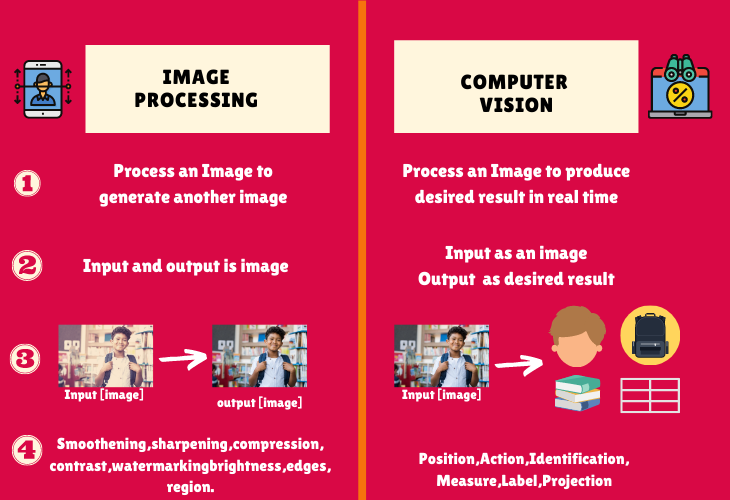
Computer Vision vs Image Processing, while closely related, have different roles.
Computer vision is like the “brain” behind visual understanding. It helps machines interpret and make sense of the visual world, similar to how humans see. It deals with complex tasks like recognizing objects, understanding scenes, and gaining insights from images and videos.
On the other hand, image processing is like the “craftsman” that focuses on enhancing and modifying images to improve quality, extract specific details, or prepare them for further analysis. This includes tasks such as reducing noise, sharpening, and adjusting contrast and colors.
The input and output differ as well; computer vision processes images, sequences of images, or videos to produce interpretations, often non-visual.
Image processing involves both input and output as images, resulting in refined or altered versions of the original. While computer vision seeks to understand and make decisions based on visual data using complex algorithms and techniques, image processing applies simpler operations directly to pixels, focusing on enhancing visual appearance.
computer vision applications include autonomous vehicles, medical image analysis, and surveillance, while image processing is used in image editing, medical imaging enhancements, and remote sensing.
What Are Common Tasks That Computer Vision Can Perform?
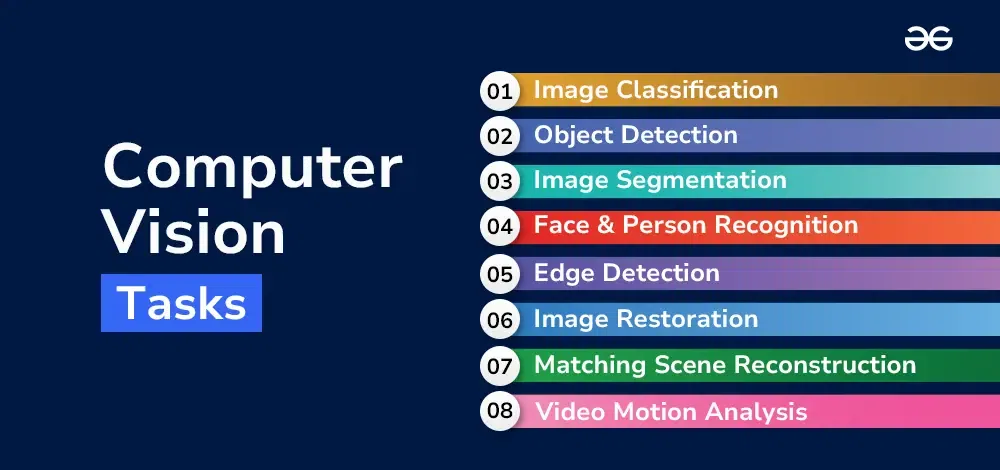
Computer vision involves teaching machines to see and understand pictures and videos from the world around them. This helps machines to look at images and videos, find important details, and make decisions based on what they see.
The primary goal is to replicate human vision capabilities in machines, facilitating various applications across different industries.
Common tasks that computer vision can perform include:
-
- Object Detection: Finding and marking objects in a picture or video.
-
- Image Classification: Sorting images into groups or labels.
-
- Semantic Segmentation: Breaking an image into parts with labels, showing boundaries and objects.
-
- Face Recognition: Identifying people using their facial features.
-
- Motion Detection: Noticing and following movement in a video.
-
- Optical Character Recognition (OCR): Turning documents, like scanned papers or photos, into editable text.
-
- Image Generation: Making new images by using patterns from a dataset.
-
- Anomaly Detection: Spotting unusual image patterns or defects, useful for quality control and surveillance.
-
- 3D Scene Reconstruction: Creating a 3D model from 2D pictures.
How FOLIO3 AI Simplifies Computer Vision Tasks
Folio3 AI boosts computer vision tasks by offering advanced, customizable solutions for different industries. We specialize in creating and using AI-powered visual inspection systems that make quality control more accurate and efficient.
Folio3 AI uses deep learning and convolutional neural networks (CNNs) to automate tasks like object detection, image classification, and irregularity detection, reducing manual work. Our computer vision applications also enable real-time video analysis for security and surveillance, as well as AR and VR projects.
In summary, Computer Vision is changing many industries by making things more efficient, and accurate, and helping with decisions. As the technology gets better, it will be used in more areas, becoming important in fields like healthcare, cars, retail, and others.
With Folio3 AI’s skill in providing great, customizable solutions, businesses can use Computer Vision to drive innovation and stay ahead in a competitive market.

Dawood is a digital marketing pro and AI/ML enthusiast. His blogs on Folio3 AI are a blend of marketing and tech brilliance. Dawood’s knack for making AI engaging for users sets his content apart, offering a unique and insightful take on the dynamic intersection of marketing and cutting-edge technology.

